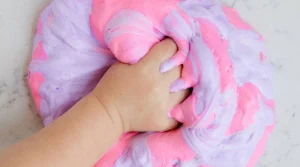
What Do Slime Toys Do? The Science and Learning Behind Slime
Curious about slime toys? Learn what they do and how they help children learn, create, and develop essential skills naturally.
#1 Toys Manufacturer in China. WhatsApp: +86 180-0088-4063. Email: [email protected]
#1 Toys Manufacturer in China. WhatsApp: +86 180-0088-4063. Email: [email protected]

Slime has become more than just a trend—it’s a staple in the world of sensory toys. Loved by kids, teens, and even adults, slime captivates people with its ability to stretch, squish, and morph into endless forms.
Regular slime is the classic, gooey, stretchy mixture that started the slime craze. Its appeal lies in its unique, tactile feel—easy to stretch, shape, and even drip. Regular slime’s simple formula allows endless customization, making it popular among both beginners and experienced slime makers.
Traditional slime is typically smooth and pliable, with a satisfying stretch that many find almost therapeutic.
The basic recipe includes glue, often PVA-based, and a type of activator. Commonly, this activator is a borax solution, which triggers a chemical reaction that transforms the glue into a thick, moldable material.
This reaction creates slime’s signature elasticity. Some variations add ingredients like lotion or shaving cream for texture, but they still maintain the classic gooey quality.
Regular slime isn’t limited to one type; there are many forms. Each type has its own sensory appeal and unique characteristics, allowing for a variety of experiences even within the category of regular slime.
| Type | Characteristics | Sensory Appeal |
|---|---|---|
| Fluffy Slime | Contains shaving cream for a soft, airy feel. | Light and soft texture that’s easy to squeeze. |
| Clear Slime | Made without color or add-ins, glossy and transparent. | Smooth and visually appealing with a glass-like look. |
| Glitter Slime | Includes glitter for extra shimmer and sparkle. | Shiny and decorative, satisfying to stretch and shape. |
While it’s fun to play with, regular slime has also become a popular sensory tool. Its pliable nature provides a hands-on, calming activity that can help people unwind and focus.
For some, squeezing or stretching slime offers a gentle way to relieve stress, while others enjoy using it as a creative outlet, shaping it into different forms or mixing in add-ons like tiny foam balls for texture.
Regular slime remains a staple for sensory enthusiasts, even as new types like butter slime emerge on the scene.
Butter slime stands out in the world of slime varieties due to its uniquely smooth, moldable, and satisfying texture.
Unlike the stretchier, gooier regular slime, butter slime feels almost like softened butter. Its thicker consistency makes it ideal for spreading and shaping, making it popular for those looking for a different sensory experience.
Butter slime’s defining feature is its soft, spreadable feel. It’s thicker and smoother than regular slime, making it easier to mold into shapes that hold their form. Its texture is often described as buttery, with a softness that’s almost dough-like.
Because of this, butter slime doesn’t drip or ooze in the same way as traditional slime, which some people prefer for its mess-free quality.
Butter slime starts with a base of standard slime ingredients like glue and activator, but what makes it different is the addition of soft clay.
| Ingredient | Purpose | Effect on Texture |
|---|---|---|
| Glue | Forms the base of the slime | Provides elasticity and stretchability |
| Activator | Reacts with glue to thicken the mixture | Creates the stretchy, cohesive texture |
| Soft Clay | Typically lightweight, air-dry clay | Adds smoothness, thickness, and a buttery, spreadable feel |
The name “butter slime” isn’t just for fun—it reflects the slime’s buttery qualities. Its soft, spreadable nature reminded early creators of softened butter, and the name stuck.
In fact, many people enjoy pressing and spreading butter slime just as they would with real butter, though, of course, this slime is purely for play.
For those who enjoy tactile play, butter slime offers a calming and satisfying experience. The thick, soft feel can be relaxing to mold and stretch, making it popular in sensory play.
Unlike regular slime, which stretches in long, stringy pulls, butter slime is often spread or flattened, creating a different sort of engagement. It provides a tactile alternative to regular slime, giving sensory enthusiasts a unique texture to explore.
Here’s a concise breakdown of the main differences between butter slime and regular slime. This comparison table highlights their unique qualities, helping you understand which type might best suit different sensory experiences.
| Aspect | Butter Slime | Regular Slime |
|---|---|---|
| Texture Comparison | Smooth and spreadable, holds its shape well, similar to softened butter | Stretchy and sticky, ideal for pulling and stretching |
| Ingredients and Formulation | Contains glue, activator, and soft clay for added thickness and softness | Made with glue and an activator, no clay, resulting in a more elastic, classic slime texture |
| Play and Manipulation | Easy to mold and shape, holds forms well | Highly elastic, ideal for fidgeting and stretchy play |
| Visual and Sensory Appeal | Matte, creamy look and dense feel, often perceived as calming | Glossy or clear, with a bouncy, sticky feel that offers a traditional slime experience |
Butter slime provides a thicker, moldable texture perfect for shaping, while regular slime emphasizes elasticity and is more suited to stretching play.
Making slime is a fun, hands-on activity that offers insight into basic chemical reactions. While regular slime and butter slime share some similarities, their unique textures require slightly different approaches.
>> How to Make Slime More Stretchy: Ultimate Guide for Beginners
To make regular slime, start with the following ingredients:
Regular slime is known for its stretchy, gooey texture, ideal for pulling and bouncing. The key ingredient here is the contact solution, which helps the glue form into the familiar, elastic texture.
Butter slime has a creamy, smooth texture that’s easy to spread and mold. To make butter slime, the recipe is slightly different due to the addition of clay, which gives it that “buttery” feel.
Butter slime’s consistency comes from the combination of glue, shaving cream, and clay. The more cornstarch or clay powder you use, the smoother and thicker it becomes. This makes butter slime easier to shape and mold compared to regular slime.
>> The Science Behind Butter Slime Unique Ingredients
Both butter slime and regular slime have their own appeal, each offering unique experiences for slime enthusiasts. Whether you prefer the smooth, moldable texture of butter slime or the stretchy, elastic feel of regular slime, each has its advantages and some downsides.
Butter slime is often praised for its smooth, creamy texture that makes it easy to handle. Here are some of the benefits:
Regular slime is the classic version that many people first try, and it comes with its own set of benefits:
While both butter slime and regular slime have their perks, they also come with some downsides.
| Drawbacks | |
|---|---|
| Butter Slime |
1. Higher Ingredient Cost: Requires more ingredients like clay or cornstarch, making it more expensive to make or buy. 2. Less Stretchy: Not as elastic as regular slime, which may be a drawback for those who prefer a more stretchy slime. |
| Regular Slime |
1. Messy: Can be sticky and messy, especially if overactivated, requiring more careful handling. 2. Less Moldable: Does not hold its shape as well as butter slime, making it harder to mold into specific forms. |
Butter slime is ideal for those who enjoy smooth, sensory experiences, while regular slime offers stretchiness and flexibility for creative and customizable play. Both types have their pros and cons, so it’s worth experimenting with each to see which one suits your needs the best.
When deciding between butter slime and regular slime, it’s important to consider factors like age and specific preferences. Both types offer unique experiences, but one might suit different needs better.
Butter Slime is a great choice for younger children due to its smooth, spreadable texture. The buttery consistency is easier to handle, making it less messy and more manageable for younger hands. It’s also a good fit for sensory play, which is often beneficial for children developing their fine motor skills.
The fact that it holds its shape well means kids can mold and shape it into various forms with ease.
For teens and adults, regular slime might be the more appealing choice. Its stretchy and elastic nature can be satisfying for those who enjoy a more dynamic texture.
>> Slime Without Borax: An Educational Toy Good for Kids?
If sensory stimulation is a priority, butter slime offers a distinctive experience. Its soft, smooth texture feels like soft butter, providing a relaxing, tactile experience. This makes it perfect for anyone seeking a more calming sensory activity, as it doesn’t require the same level of stretching or manipulation as regular slime.
People looking for a sensory toy that offers a soothing, easy-to-handle experience might lean toward butter slime.
On the other hand, regular slime is better for those who prefer a more elastic, interactive experience. It offers more stretch and can be kneaded, pulled, or twisted, which provides a more dynamic sensory engagement.
Regular slime’s versatility with add-ins makes it ideal for those who like to experiment with different textures or colors.
While both butter slime and regular slime are fun and engaging, it’s important to handle them safely.
When making butter slime or regular slime at home, always use non-toxic ingredients. Look for clear labels that indicate the slime is safe for children and adults.
Ingredients like white glue, baking soda, and contact lens solution are common in slime recipes and generally safe if used in proper amounts. For butter slime, you may need additional ingredients like clay, which is usually non-toxic as well.
However, it’s crucial to supervise younger users during slime play. Slime should never be ingested, so make sure hands are washed after handling it. For homemade slimes, ensure measurements are accurate to avoid any chemical imbalances that could cause irritation.
Proper storage is key to keeping butter slime and regular slime fresh. Both types of slime should be stored in airtight containers when not in use. This prevents them from drying out and losing their texture.
Regular slime, with its stretchy quality, can lose its elasticity if exposed to air for long periods. Similarly, butter slime, with its softer consistency, can harden over time without proper storage.
If you notice that the slime is becoming a bit too firm, adding a small amount of water (for regular slime) or lotion (for butter slime) can help restore its original texture. Keep both types in a cool, dry place, away from direct sunlight, to preserve their qualities.
Some individuals may be sensitive to the ingredients used in slime.
If you’re uncertain about any ingredients, it’s best to test a small amount on the skin before full use.
For individuals with known allergies or sensitive skin, consider using alternative recipes. There are borax-free slime options available that use cornstarch, baking soda, and other gentle ingredients.
Always check the product label or ask the manufacturer for ingredient details to ensure safety.
Both butter slime and regular slime offer unique tactile experiences and endless fun, but they cater to different preferences. Butter slime’s smooth, spreadable texture contrasts with the stretchy, gooey nature of regular slime. Choosing between the two depends on personal sensory needs and play style.
While traditional butter slime is known for its smooth, spreadable texture thanks to the inclusion of clay, you can experiment with alternatives like cornstarch or baby powder to achieve a similar consistency. However, the texture might not be as soft and "buttery" as the original.
Both butter slime and regular slime can last for a long time if stored properly. However, butter slime may dry out a bit faster due to the added clay. Regular slime, with its more elastic texture, tends to retain moisture longer when stored in an airtight container.
Yes, you can mix butter slime with regular slime for a fun, hybrid texture. The result will be a slime that combines butter slime's smoothness with the stretchiness of regular slime, creating a unique tactile experience.
Regular slime tends to be messier due to its sticky, gooey nature, which can cling to fabrics and surfaces. Butter slime, while still somewhat sticky, is easier to clean up since it’s less likely to leave residue or stains on most surfaces.
Typically, both butter slime and regular slime come in a variety of scents, depending on the ingredients and additives. However, butter slime may sometimes have a more noticeable scent due to the added clay or other materials used in its formulation. The scent, however, can vary based on the brand or DIY recipe.
More Related...

Curious about slime toys? Learn what they do and how they help children learn, create, and develop essential skills naturally.

Uncover the science of thermochromic slime — where chemistry meets creativity through playful, color-changing reactions.

Uncover why slime play is more than fun—7 benefits include sensory learning, creativity, and fostering emotional and cognitive development.

Understand how stress-relief putty helps manage anxiety, improve focus, and promote relaxation through tactile sensory play.

Our team will answer your inquiries within 48 hours.
Copyright © 2025 GuangDong AKIA Technology Co,. Ltd. All Rights Reserved